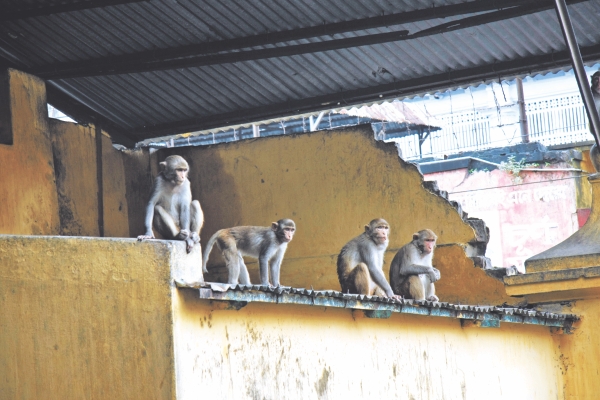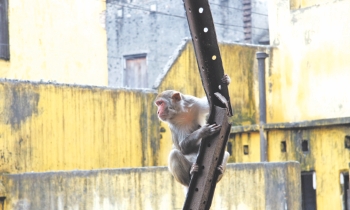| Home - Back Issues - The Team - Contact Us |
 |
| Volume 11 |Issue 03| January 20, 2012 | |
|
|
Wildlife
Dhaka’s Sprightly Residents Mahtabi Zaman There was a time when Dhaka was well-populated with wildlife. The existence of animals, belonging to different species, was a unique feature of the city. Even the Royal Bengal Tiger honoured the city with its presence. Today however, the wildlife culture in the 'human jungle' of Dhaka has been narrowed down to some stray dogs and cats, and birds like crows and sparrows. Interestingly though, a large number of Rhesus monkeys co-exist with humans in the densely populated regions of Old Dhaka. It is almost impossible to visit Old Dhaka and not be welcomed by the sight of monkeys jumping from one building to another. These monkeys are generally found at Gandaria, Tanti Bazar, Shakhari Bazar, Goal Nagar and Banagram Wari in Old Dhaka. So, why are these areas so densely populated with monkeys? Upon visiting the above mentioned places, certain factors that make these places habitable for monkeys, were brought to light. Firstly, these areas are densely populated and the houses are attached to each other. There are many century-old-buildings that are not higher than three storeys. This feature of Old Dhaka allows the monkeys to easily shift from one building to another.
Secondly, the area also hosts residential compounds with open spaces and plenty of trees. The open space and food from trees attract the monkeys to these compounds. The presence of the Hindu community in these areas also contributes to the high concentration of the monkeys. Mohammed Mostafa Feeroz, Professor of Zoology department of Jahangirnagar University and a member of Wildlife Advisory Board says, “For religious reasons, the Hindu community reveres these monkeys. As a result, even if they become annoyed with the activities of monkeys, they do not get rid of them. These monkeys do not look for natural resources or try to go to other areas, because they get enough food from people belonging to these communities.” According to Sadhana Aushadhalaya, that runs a herbal medication factory at Gandaria, the plant provides eight kilograms of wet-chickpea to around 200 monkeys every evening. People outside Old Dhaka visit Sadhana to see the monkeys often and they too, feed the animals. About the concentration of Rhesus monkeys at Old Dhaka, Feeroz, says, "There are three perspectives behind it. Firstly, monkeys were available all over Dhaka two to three hundred years ago. With expanding human habitation, natural habitat started to decline in the city. The monkeys started to leave Dhaka in search of nature. We know about ten species of monkeys in Bangladesh. Rhesus monkey is the only species which can adjust in human settlements.” “The breeding capacity of monkeys increase when they get adequate food from human beings,” adds Feeroz. According to his research conducted on the monkeys of Char Muguria at Madaripur, the population of Rhesus monkeys in 2002 was around 300, and came in three groups. Their number increased to around 750 within five years. Feeroz says, “The government authority used to feed these monkeys during that period at Char Muguria. If the urban monkeys do not receive extra-food from human beings, 45 to 50 percent fewer female monkeys would breed every year, which would decrease the population by 40 percent." Professor Feeroz suggests stopping the food provision food to the monkeys. Firstly, it would help reduce their population growth which would eventually force them to go to other places for food. According to Shahana Chowdhury, a housewife who lives near Shadhana Aushadhalaya at near Ganderia, these monkeys have become a nuisance to many habitants of Old Dhaka. "People are fed up by the activities of these monkeys. We have to pluck the green mangoes at an early stage; otherwise the monkeys destroy them. They also destroy the flowers at home." Radha Rani a resident at Goalnagar voices similar concerns,"The monkeys were not as irritating before as they are now. Frightening the children, they snatch food from their hands. They steal and take food by force from our kitchens. They take clothes from our roof-tops. Sometimes, they take the clothes as ransom, because when we give them food, they leave that piece of cloth." Sankar Baroi, another resident at Shankhari Bazar says, "In our area, electricity cables are spread like nets. So, incidents of electrocution of the monkeys occur very often." Samia Saif, a Zoology student of Dhaka University conducted extensive research on the conflict between Rhesus Monkeys at Shadhana Aushadhalaya and human beings in 2009. In her research, she found out that due to regular interaction between mankind and the primates, the latter is not afraid of them. If people take any serious action like beating, killing or throwing hot starch on them, the primates unite and take revenge later. “The monkeys in Old Dhaka did not grow here all of a sudden. They have been residing here before mankind started their settlement. Rather mankind has created problems for the monkeys. So the thought of banishing the primates away from this area is very astounding,” says Professor Feeroz when asked what steps can be undertaken to manage the monkeys in Old Dhaka. While these monkeys may be an integral part Old Dhaka's heritage, it isn't always practically viable for human beings to co-exist with the Rhesus monkeys. Concerned authorities should step in and work towards striking a balance for a peaceful co-existence in these areas of Old Dhaka.
Copyright (R) thedailystar.net 2012 |
||||

